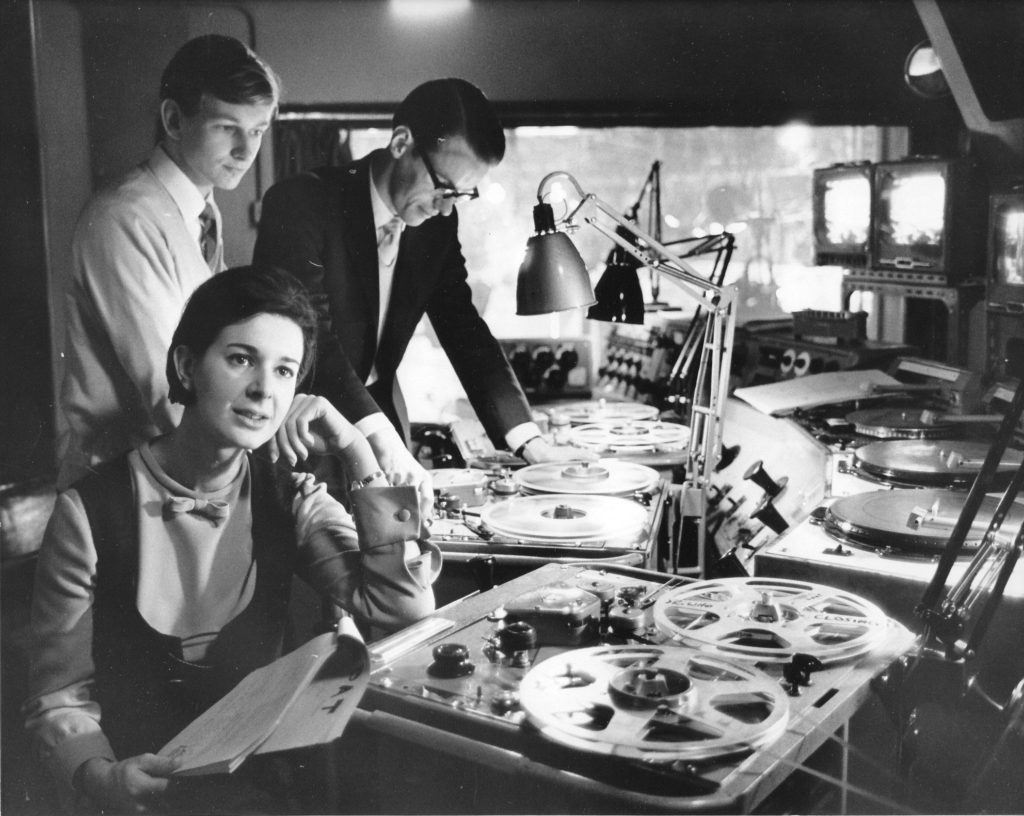From Pat Heigham
This photo appeared some 45 years after it was taken, sent to me by the chaps who are restoring the very first episodes of “Dr. Who”, believed to be from film telerecordings.

It was in the property of the late Verity Lambert, who was the executive producer of the early “Dr. Who” series and depicts Adrian Bishop-Laggett and myself, with Verity, in the Sound Control room of Studio D, Lime Grove (sadly non-existent anymore, flats now stand on the site).
Bish and I think it must have been around 1963-4, as he was the Grams Operator at the time and I was double-banking him, prior to taking over that job on his promotion to Sound Supervisor. I stayed with the show for about three years, had a break and came back to it again in 1968.
As a rule, the usual routine for working on the series, was attendance at ‘outside rehearsals’ in a drill-hall somewhere, to witness a run-through, a chat with the director if anything special was required in the way of sound FX, then back to Television Centre for a pie and pint in the club, before hitting the Gram Library to audition FX recordings needed. After that, a short journey down to Studio R in Lime Grove, a dedicated sound facility, to assemble the reels of tape to be used at the studio recording, which was done in one day for a half-hour episode. The programme was videotaped to 2” Ampex (405 line B/W in those days!) and any recording breaks meant that the videotape had to be physically cut and spliced. Spot FX were played in at the time, and any bridging music links or changes in b/g atmos were added over the edits in a re-recording session later.
Many of the sound effects were created by the Radiophonic Workshop at Maida Vale Studios and I often drove over to liaise with Brian Hodgson and collect any specialised material. I do remember belting my mother’s twin-tub AEG washing machine which produced the most wonderful array of motor whines, switch clonks and whooshes, when I could take home a Uher or Nagra.
The tape machines in the picture are EMI TR90’s – a beautiful piece of kit, running at 15 or 7.5 ips with an amazingly fast start, which made ‘spot’ cueing a reality. They were two-track, which was useful for long atmospheres, as the switch between them was done with a quick flick of the faders. BBC rotary faders had a 180° travel only, so from zero to flat out was extremely fast.
Later programmes, using the sound desks in TVC had the facility of a sound source auto-following the vision mixer cuts. It is possible to see, disappearing off the nearest machine, a long tape loop, which extended across the gallery and round a cine spool mounted on a pencil taped to a mike stand! It was a challenge to edit the loop so that the audio join was not discernable on either of the two tracks. No computers in those days!
The Dalek voices were largely down to the actor Peter Hawkins, who produced most of the characteristic metallic rendition, helped a bit with a ring-modulator which put in the ‘broken-up’ pattern. If there were multiple Dalek speeches, then some were pre-recorded and played in off-tape. I remember one occasion when I looked down at my script, realised that I had not cued the last dialogue line of the scene, and left Deborah Watling (Victoria) with egg on her face, waiting to react!
As most sound FX were relayed to the studio floor (foldback) for actors to react, I did have a bit of fun with Carole Ann Ford, who was due to leave the show, as ‘she had fallen for a chap on another planet’ and was not going to travel with grandfather anymore. Her dialogue line: “Oh, David, I love you, I really do!” was absolutely asking for the addition of the soupiest, schmaltziest Hollywood strings that I could find – and she got them! It stopped the rehearsal, with her saying: “Well, I’ve never been sent up like that before!”



